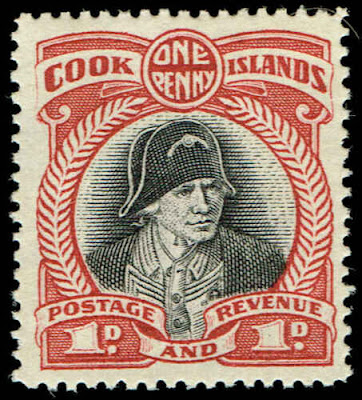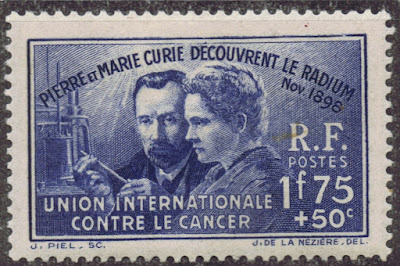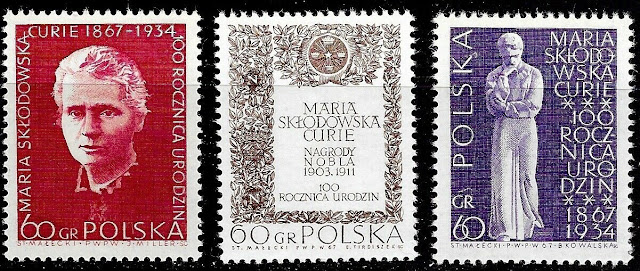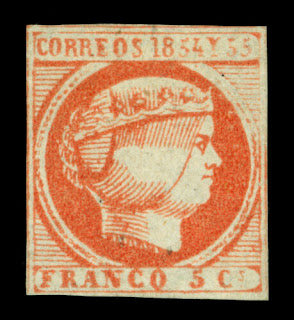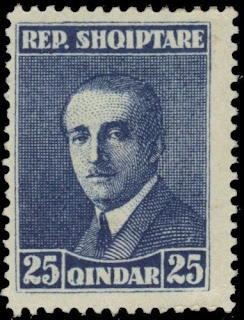Thursday, November 07, 2019
November 7th in stamps Cornelis Drebbel, Marie Curie, James Cook, Ingrid of Sweden
Thursday, October 10, 2019
October 10th in stamps Tasman, Isabella II, Carinthian plebiscite
1659 Died: Abel Tasman, Dutch merchant and explorer (b. 1603)
Abel Janszoon Tasman (1603 – 10 October 1659) was a Dutch seafarer, explorer, and merchant, best known for his voyages of 1642 and 1644 in the service of the Dutch East India Company (VOC). He was the first known European explorer to reach the islands of Van Diemen's Land (now Tasmania) and New Zealand, and to sight the Fiji islands.
Tasman's ten-month voyage in 1642–43 had significant consequences. By circumnavigating Australia (albeit at a distance) Tasman proved that the small fifth continent was not joined to any larger sixth continent, such as the long-imagined Southern Continent. Further, Tasman's suggestion that New Zealand was the western side of that Southern Continent was seized upon by many European cartographers who, for the next century, depicted New Zealand as the west coast of a Terra Australis rising gradually from the waters around Tierra del Fuego. This theory was eventually disproved when Captain Cook circumnavigated New Zealand in 1769.
1830 Born: Isabella II of Spain (d. 1904)
Isabella II (Spanish: Isabel; 10 October 1830 – 9 April 1904), also known as La de los Tristes Destinos or the One with the Sad Destinies, was Queen of Spain from 1833 until 1868. She came to the throne as an infant, but her succession was disputed by the Carlists, whose refusal to recognize a female sovereign led to the Carlist Wars. After a troubled reign, she was deposed in the Glorious Revolution of 1868, and formally abdicated in 1870. Her son, Alfonso XII, became king in 1874.
Stamps from Spain and the Spanish Philippines depicting Isabella II
1920 – The Carinthian plebiscite determines that the larger part of the Duchy of Carinthia should remain part of Austria.
The Carinthian plebiscite (German: Kärntner Volksabstimmung, Slovene: Koroški plebiscit) was held on 10 October 1920 in the area predominantly settled by Carinthian Slovenes. It determined the final southern border between the Republic of Austria and the newly formed Kingdom of Serbs, Croats and Slovenes (Yugoslavia) after World War I.
The outcome of the plebiscite held on 10 October, was 22,025 votes (59.1% of the total cast) in favor of adhesion to Austria and 15,279 (40.9%) in favor of annexation by the Kingdom of the Serbs, Croats, and Slovenes. Assumed that the whole German-speaking minority had voted for Austria, also every second Carinthian Slovene had decided to remain with the Republic. While a majority in the remote Alpine villages on the slopes of the Karawanks range voted for Yugoslavia, the inhabitants of the densely settled Klagenfurt Basin were motivated by their evolved social and cultural, not least economic ties to the central Carinthian region.
After the Austrian option had gained a majority of votes in predominantly Slovene Zone A, the second stage of the referendum in northern Zone B, populated chiefly by German speakers, was not carried out. Another Yugoslav foray was fiercely rejected by the Entente powers. The Carinthian Plebiscite region was placed under Austrian administration on 18 November 1920 and declared part of the sovereign Austrian Republic on November 22. Up to today, October 10 is a public holiday in the State of Carinthia.
The plebiscite ultimately determined the border between Austria and the Kingdom of Serbs, Croats, and Slovenes. The border remained unchanged after World War II, even as the Kingdom of Yugoslavia gave way to Josip Broz Tito's Socialist Federal Republic of Yugoslavia, though at the end of the war Yugoslav Partisans again briefly occupied the area, including the capital city of Klagenfurt. Since the disintegration of Yugoslavia, the border has separated Austria and Slovenia.
Austrian stamps commemorating 30 years since the Carinthian plebiscite
Tuesday, October 08, 2019
October 8 in stamps Heysen, Zog I, WIlly Brandt, Otto Warburg, Franklin Pierce
1869 Died: Franklin Pierce, American general, lawyer, and politician, 14th President of the United States (b. 1804)
Franklin Pierce (November 23, 1804 – October 8, 1869) was the 14th president of the United States (1853–1857), a northern Democrat who saw the abolitionist movement as a fundamental threat to the unity of the nation. He alienated anti-slavery groups by supporting and signing the Kansas–Nebraska Act and enforcing the Fugitive Slave Act, yet he failed to stem conflict between North and South, setting the stage for Southern secession and the American Civil War.
Pierce was born in New Hampshire; he served in the U.S. House of Representatives and Senate until his resignation in 1842. His private law practice was a success, and he was appointed New Hampshire's U.S. Attorney in 1845. He took part in the Mexican–American War as a brigadier general in the Army. He was seen by Democrats as a compromise candidate uniting northern and southern interests and was nominated as the party's candidate for president on the 49th ballot at the 1852 Democratic National Convention. He and running mate William R. King easily defeated the Whig Party ticket of Winfield Scott and William A. Graham in the 1852 presidential election.
As president, Pierce simultaneously attempted to enforce neutral standards for civil service while also satisfying the diverse elements of the Democratic Party with patronage, an effort which largely failed and turned many in his party against him. He was a Young America expansionist who signed the Gadsden Purchase of land from Mexico and led a failed attempt to acquire Cuba from Spain. He signed trade treaties with Britain and Japan, while his Cabinet reformed their departments and improved accountability, but these successes were overshadowed by political strife during his presidency. His popularity declined sharply in the Northern states after he supported the Kansas–Nebraska Act, which nullified the Missouri Compromise, while many whites in the South continued to support him. Passage of the act led to violent conflict over the expansion of slavery in the American West. Pierce's administration was further damaged when several of his diplomats issued the Ostend Manifesto calling for the annexation of Cuba, a document which was roundly criticized. He fully expected to be renominated by the Democrats in the 1856 presidential election, but was abandoned by his party and his bid failed. His reputation in the North suffered further during the American Civil War as he became a vocal critic of President Abraham Lincoln.
Pierce was popular and outgoing, but his family life was a grim affair, with his wife Jane suffering from illness and depression for much of her life. All of their children died young, their last son being gruesomely killed in a train accident while the family was traveling shortly before Pierce's inauguration. He was a heavy drinker for much of his life, and he died of cirrhosis of the liver in 1869. Historians and scholars generally rank Pierce as one of the worst and least memorable U.S. Presidents.
US stamps depicting Franklin Pierce
Sir Hans Heysen (8 October 1877 – 2 July 1968) was a German-born Australian artist. He became a household name for his watercolours of monumental Australian gum trees. Heysen also produced images of men and animals toiling in the Australian bush, as well as groundbreaking depictions of arid landscapes in the Flinders Ranges. He won the Wynne Prize for landscape painting a record nine times.
Wilhelm Ernst Hans Franz Heysen was born in Hamburg, Germany. He migrated to Adelaide in South Australia with his family in 1884 at the age of 7. As a young boy Heysen showed an early interest in art. At 14 he left school to work with a hardware merchant, later studying art during nights at Art School in his spare time, under James Ashton. He joined the Adelaide Easel Club in 1897 and was immediately recognized as a rising talent.
At age 20 he was sponsored by a group of wealthy Adelaide art enthusiasts H. H. Wigg and brothers-in-law W. L. Davidson, and F. A. Joyner, and miner Charles Henry de Rose to study art for four years in France.
By 1912 Hans Heysen had earned enough from his art to purchase a property called "The Cedars" near Hahndorf in the Adelaide Hills, which remained as his home until his death in 1968 aged 90. Hans Heysen is best remembered for his remarkable paintings depicting sheep and cattle among massive gum trees against a background of stunning atmospheric effects of light
Australian stamp issued in 1974 featuring a painting by Hans Heysen
1883 Born: Otto Heinrich Warburg, German physiologist and physician, Nobel Prize laureate (d. 1970)
Otto Heinrich Warburg (8 October 1883 – 1 August 1970), son of physicist Emil Warburg, was a German physiologist, medical doctor, and Nobel laureate. He served as an officer in the elite Uhlan (cavalry regiment) during the First World War, and was awarded the Iron Cross (1st Class) for bravery. He was the sole recipient of the Nobel Prize in Physiology or Medicine in 1931. In total, he was nominated for the award 47 times over the course of his career
While working at the Marine Biological Station, Warburg performed research on oxygen consumption in sea urchin eggs after fertilization and proved that upon fertilization the rate of respiration increases as much as sixfold. His experiments also proved iron is essential for the development of the larval stage.
In 1918, Warburg was appointed professor at the Kaiser Wilhelm Institute for Biology in Berlin-Dahlem (part of the Kaiser-Wilhelm-Gesellschaft). By 1931 he was named director of the Kaiser Wilhelm Institute for Cell Physiology, which was founded the previous year by a donation of the Rockefeller Foundation to the Kaiser Wilhelm Gesellschaft (since renamed the Max Planck Society).
Warburg investigated the metabolism of tumors and the respiration of cells, particularly cancer cells, and in 1931 was awarded the Nobel Prize in Physiology for his "discovery of the nature and mode of action of the respiratory enzyme". The award came after receiving 46 nominations over a period of nine years beginning in 1923, 13 of which were submitted in 1931, the year he won the prize.
Nobel Laureate George Wald, having completed his Ph.D. in zoology at Columbia University, received an award from the U.S. National Research Council to study with Warburg. During his time with Warburg, 1932–1933, Wald discovered vitamin A in the retina.
German stamp issued in 1983 depicting Otto Warburg
1895 Born: Zog I of Albania (d. 1961)
Zog I, King of the Albanians (Albanian: Naltmadhnija e tij Zogu I, Mbreti i Shqiptarëve, 8 October 1895 – 9 April 1961), born Ahmet Muhtar Zogolli, taking the surname Zogu in 1922, was the leader of Albania from 1922 to 1939. He first served as Prime Minister of Albania (1922–1924), then as President (1925–1928), and finally as the first and only King (1928–1939).
Albanian stamps depicting Zog I
1992 Died: Willy Brandt, German lawyer and politician, 4th Chancellor of Germany, Nobel Prize laureate (b. 1913)
Willy Brandt (18 December 1913 – 8 October 1992) was a German statesman who was leader of the Social Democratic Party of Germany (SPD) from 1964 to 1987 and served as Chancellor of the Federal Republic of Germany (West Germany) from 1969 to 1974. He was awarded the Nobel Peace Prize in 1971 for his efforts to strengthen cooperation in western Europe through the EEC and to achieve reconciliation between West Germany and the countries of Eastern Europe. He was the first Social Democrat chancellor since 1930.
Fleeing to Norway and then Sweden during the Nazi regime and working as a left-wing journalist, he took the name Willy Brandt as a pseudonym to avoid detection by Nazi agents, and then formally adopted the name in 1948. Brandt was originally considered one of the leaders of the right wing of the SPD, and earned initial fame as Governing Mayor of West Berlin. He served as Foreign Minister and as Vice Chancellor in Kurt Georg Kiesinger's cabinet, and became chancellor in 1969. As chancellor, he maintained West Germany's close alignment with the United States and focused on strengthening European integration in western Europe, while launching the new policy of Ostpolitik aimed at improving relations with Eastern Europe. Brandt was controversial on both the right wing, for his Ostpolitik, and on the left wing, for his support of American policies, including the Vietnam War, and right-wing authoritarian regimes. The Brandt Report became a recognised measure for describing the general North-South divide in world economics and politics between an affluent North and a poor South. Brandt was also known for his fierce anti-communist policies at the domestic level, culminating in the Radikalenerlass (Anti-Radical Decree) in 1972.
Brandt resigned as chancellor in 1974, after Günter Guillaume, one of his closest aides, was exposed as an agent of the Stasi, the East German secret service.
German stamps depicting Willy Brandt


